You are viewing 1 of your 1 free articles
Build up to break press and fast attacks
He led Swansea City to the Premier League, guided Liverpool to runners-up spot in the title race, and won the FA Cup with Leicester City. With Celtic, he has twice lifted a domestic treble. Now Brendan Rodgers shares a session on build-up play with Elite Soccer
| Area | Full pitch |
| Equipment | Mini goals, full size goals |
| No. of Players | 20 players + 2 goalkeepers |
| Session Time |
Warm-up: 15mins, Directional rondo: 20mins, Build-up to attack: 20mins, 11v11: 20mins |
This session is based around the theme of building up from the back against a high press, with the intention to break through the pressure and quickly attack towards goal. In this session, we want the players to find the solutions to a high press, specifically using short build-up play to take advantage of an overload.
After breaking the press, the players will then look to attack quickly towards goal, taking advantage of the space that has opened behind the high press. In this phase, the intention is to use fast and decisive actions to create a goalscoring opportunity.
In order to build an engaging session for our players, we aim to make the session both competitive and physically demanding, while also providing a context in which the team can develop with regards to our game model and principles of play. This is at the core of how we make our sessions game-realistic and best prepare the team for the demands of matchday.
This specific session allows us to improve on principles and explicit tactical ideas related to our build-up play while promoting competitiveness within all aspects of the session. It also challenges the players physically, with high demands on intensity and minimal stoppages in the session or between drills.
This is a session we use frequently, particularly when we feel the need to focus on our build-up play. This may be linked to what we expect from an upcoming opponent, or as a result of analysing our own recent matches.
We would be most likely to implement this session on MD-3. The large spaces and longer duration of this session mean it is more suitable for our more physically demanding training days, and not in the days immediately before or after a match.
Directional rondo
We set up in an area 52x30yds with 12yd central zone after the players have completed a 15-minute warm-up. The next part of the session is a directional rondo exercise. It does not demand the players to play in position or within a formation, but instead brings focus to the fundamental technical actions and broad tactical principles that are key to the success of our build-up play. In build-up, the players will start play in the deepest zone with a 7v5 overload and the intention of progressing into the central zone [1a].
1a
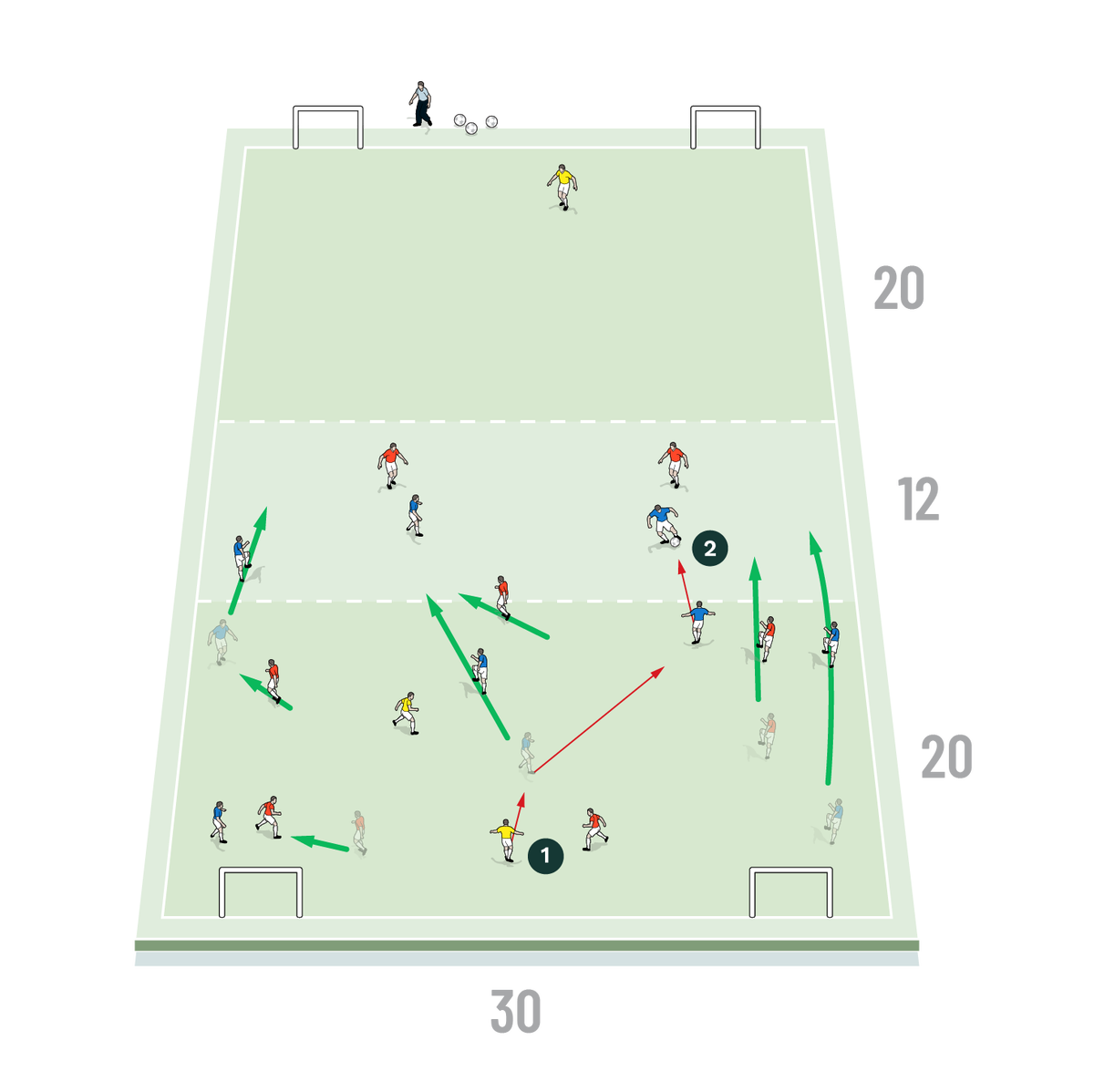
2. Blue team progress into central zone
Once the ball arrives in the central zone, players from the build-up zone are free to break forward and support the attack. From here, the intention is to launch a fast attack and look to score in the mini goals at the opposite end of the exercise [1b].
1b
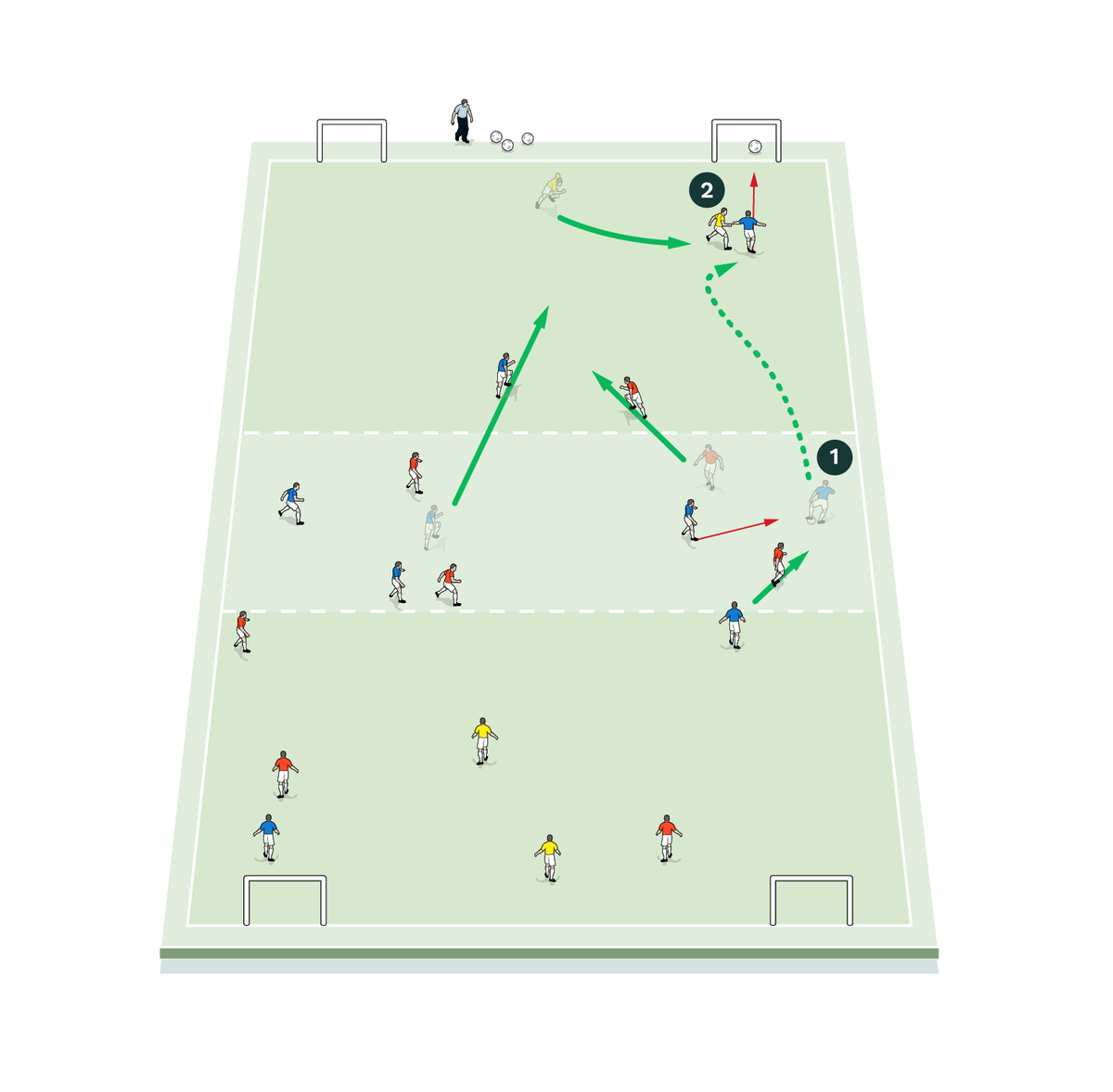
2. Blue team look to score in mini goals
If the defensive team regain the ball at any point [1c], they will look to counter-attack and score in their opponents’ mini goals [1d]. Once the attack ends, the team who had been defending now get into position for build-up, and become the attacking team. We run this for 20 minutes (4x4mins, 1min recovery).
1c
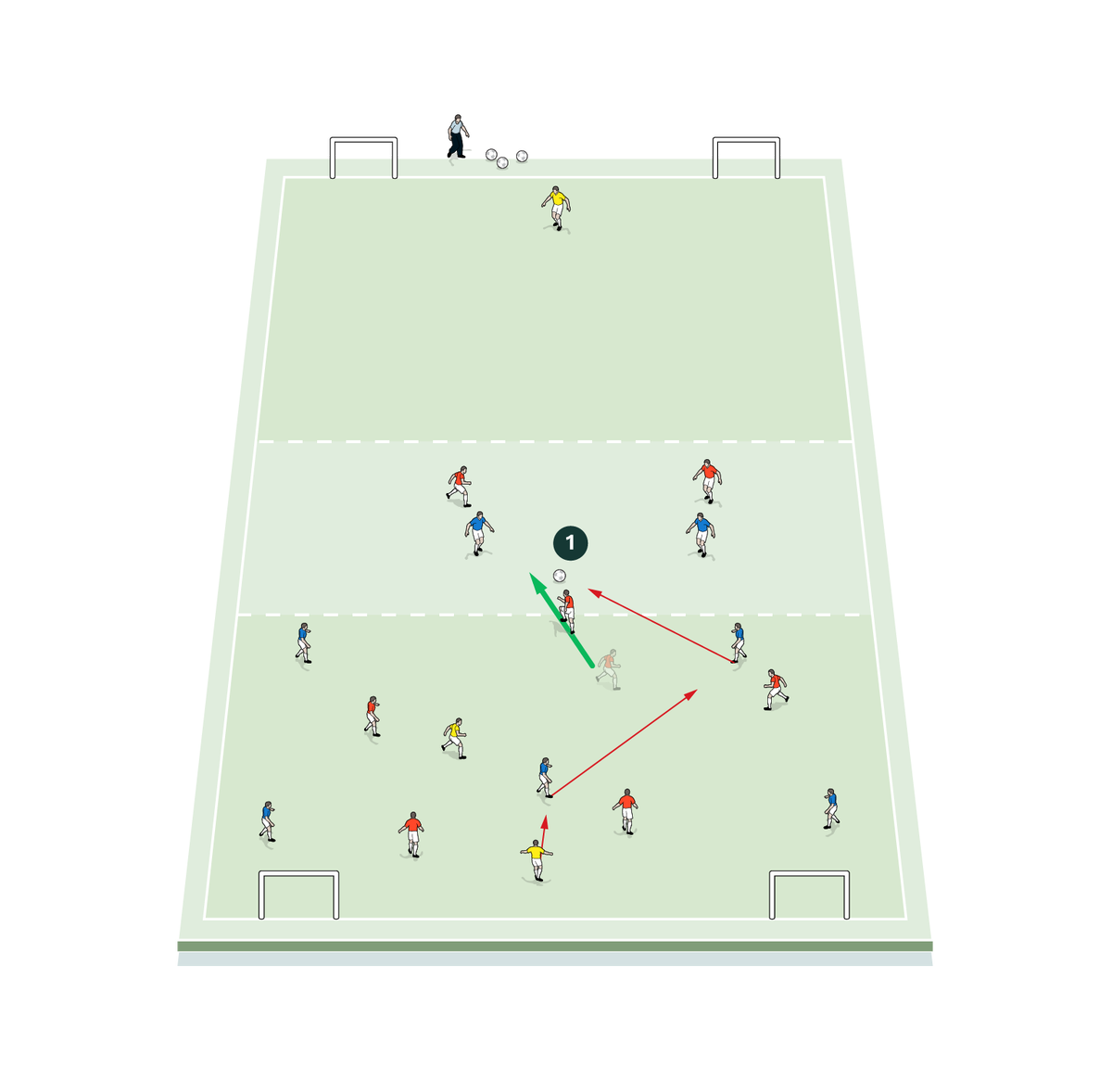
1d
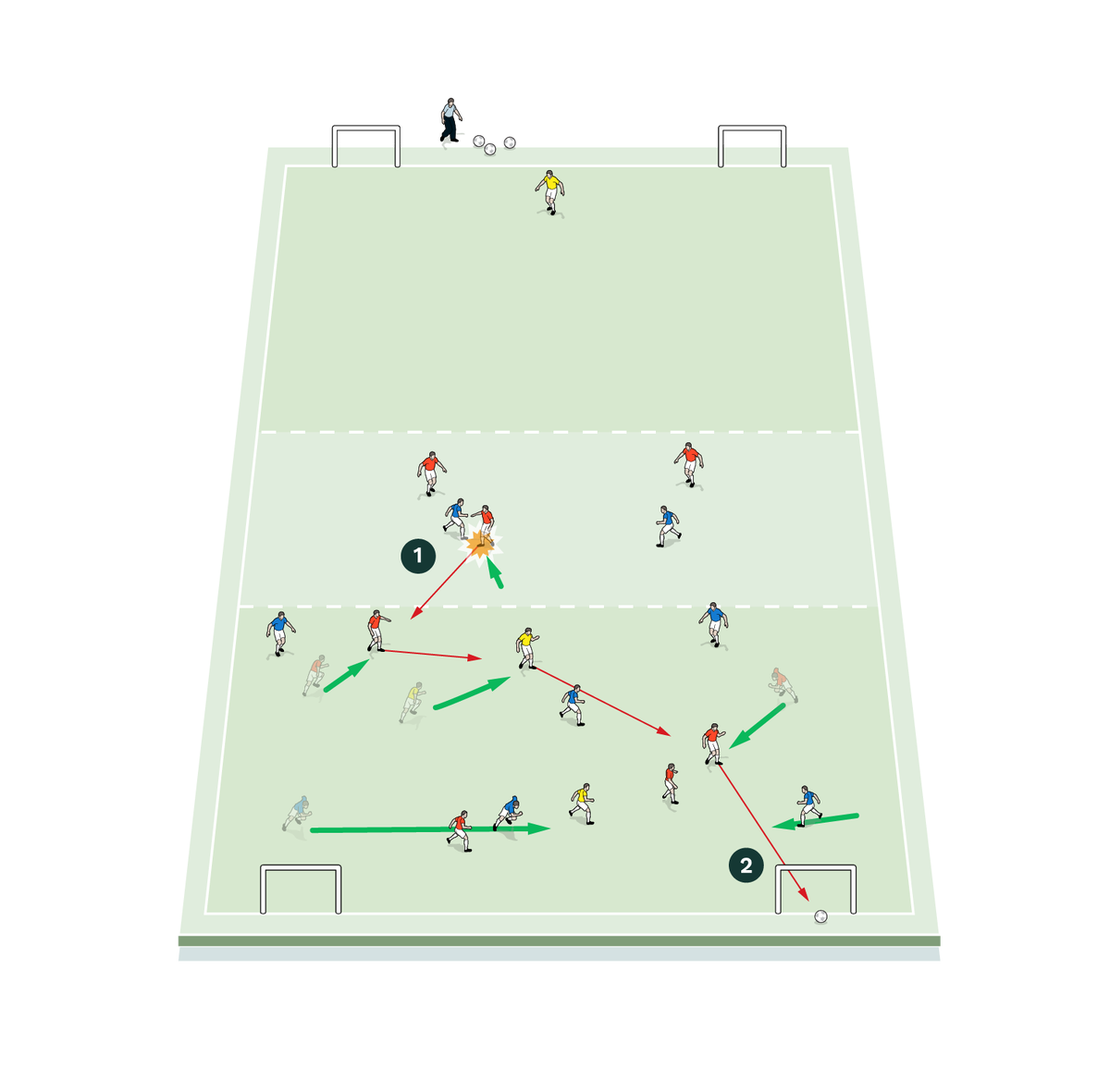
2. Red team look to score in mini goals
BUILD-UP TO ATTACK
We set up on a bigger area - build-up zone of 40x60yds, attacking zone 36x60yds, central zone 12yds – as this is many ways is a larger version of the directional rondo. Here we ask the players to apply these principles while in shape. Now the build-up zone will contain a goalkeeper, four defenders, and three midfielders. These eight players will build up against six opponents. As was the case in the previous exercise, the build-up team look to progress the ball into the middle zone, where two midfielders can then join the front three to quickly attack towards the opposition goal [2a].
2a
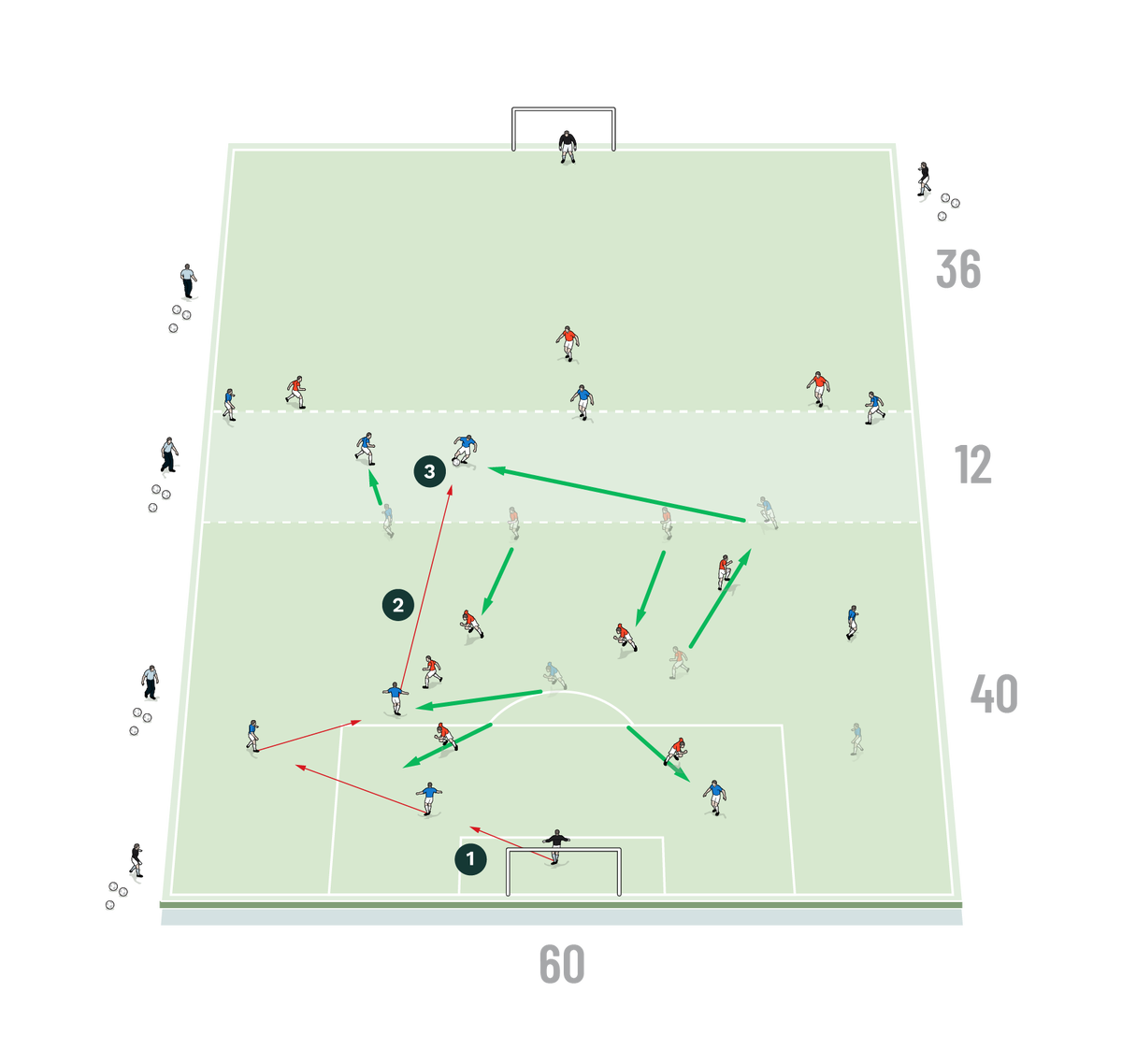
2. Blue team launch attack in build-up zone
3. Blue team reach central zone
While this 5v3 quick attack takes place, a second ball is introduced, and the remaining five players who had been building up will now defend a counter-attack against the front six of the pressing team [2b]. Once these simultaneous attacks have ended, the players will reset into the build-up starting position and repeat the process. After the first block of eight minutes, the teams switch roles, and the pressing team becomes the new build-up team.
We run this for 20 minutes (2x8mins, 2min recovery).
2b
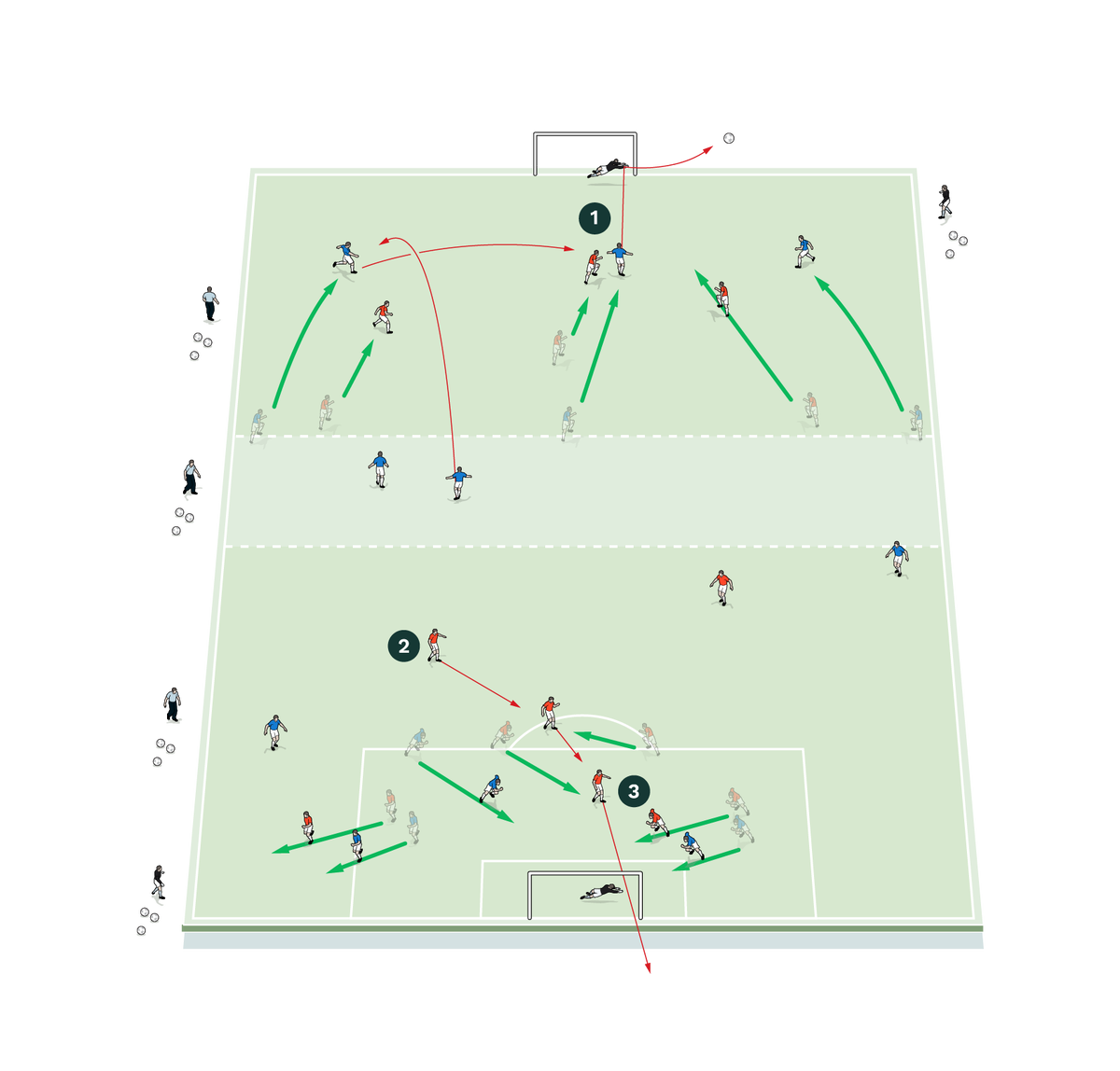
2. Coach gives second ball to red team
3. Red team look to attack
11v11
We set up on a full pitch, and finish the session with an 11v11 game. In this part of the session, the game is free play, and does not contain any specific rules or conditions relating to the build-up play ideas that have been the focus of the session. This is where the players have the chance to carry the themes of the session into a full 11v11 game format. Here, the role of the coaches is to analyse how successfully the players are implementing the key ideas of the session, particularly in relation to build-up play. Each coach may be assigned to focus on a specific unit of the team within the game.
We run this for 20 minutes (3x5mins, 90-second recovery).
What are the key things to look out for?
In the initial build-up phase, the players must be able to withstand and break the opposition high pressure. To do so, we look for a high level of technique to receive under pressure, and quickly find a pass or space to carry the ball, all with the intention of playing forward and through the pressure. Tactically, it is important that we see the players occupy key positions and make coordinated movements to test the opposition’s structure and create sufficient passing options that will allow us to progress the attack.
What are the typical mistakes players might make and how do I avoid them?
One typical mistake players might make is not taking up the right positions or offering the correct passing options in relation to the opposition press. Against each opposition system, there are key spaces we look to use in order to progress, and as such we must occupy or move into these positions in the correct moment in order to break the opposition press.
Another area we focus on when coaching this exercise is the direction of the attack once the build-up team bypasses pressure. Often the team will continue the attack down one side of the pitch, and fail to recognise the value of bringing the ball back into the centre and forcing the opponent to shift and defend across the pitch.
Finally, players must be ready to quickly switch mentally into defending the transition as the second ball is introduced. Once the pressure is broken, it is key that the back four and deepest midfielder do not stand and watch the attack unfold, but quickly prepare to defend a counter-attack. If they fail to do so, gaps may open in the structure of the defensive unit, which can be exploited on the counter.
Related Files
Editor's Picks
Deep runs in the final third
Using the goalkeeper in build-up play
Pressing principles
Intensive boxes drill with goals
Penetrating the final third
Creating and finishing
My philosophy
Pressing initiation
Compact team movement
Coaches' Testimonials

Alan Pardew

Arsène Wenger

Brendan Rodgers

Carlos Carvalhal

José Mourinho

Jürgen Klopp

Pep Guardiola

Roy Hodgson

Sir Alex Ferguson

Steven Gerrard
Coaches' Testimonials

Gerald Kearney, Downtown Las Vegas Soccer Club

Paul Butler, Florida, USA

Rick Shields, Springboro, USA

Tony Green, Pierrefonds Titans, Quebec, Canada
Join the world's leading coaches and managers and discover for yourself one of the best kept secrets in coaching. No other training tool on the planet is written or read by the calibre of names you’ll find in Elite Soccer.
In a recent survey 92% of subscribers said Elite Soccer makes them more confident, 89% said it makes them a more effective coach and 91% said it makes them more inspired.
Get Monthly Inspiration
All the latest techniques and approaches
Since 2010 Elite Soccer has given subscribers exclusive insight into the training ground practices of the world’s best coaches. Published in partnership with the League Managers Association we have unparalleled access to the leading lights in the English leagues, as well as a host of international managers.
Elite Soccer exclusively features sessions written by the coaches themselves. There are no observed sessions and no sessions “in the style of”, just first-hand advice delivered direct to you from the coach.









